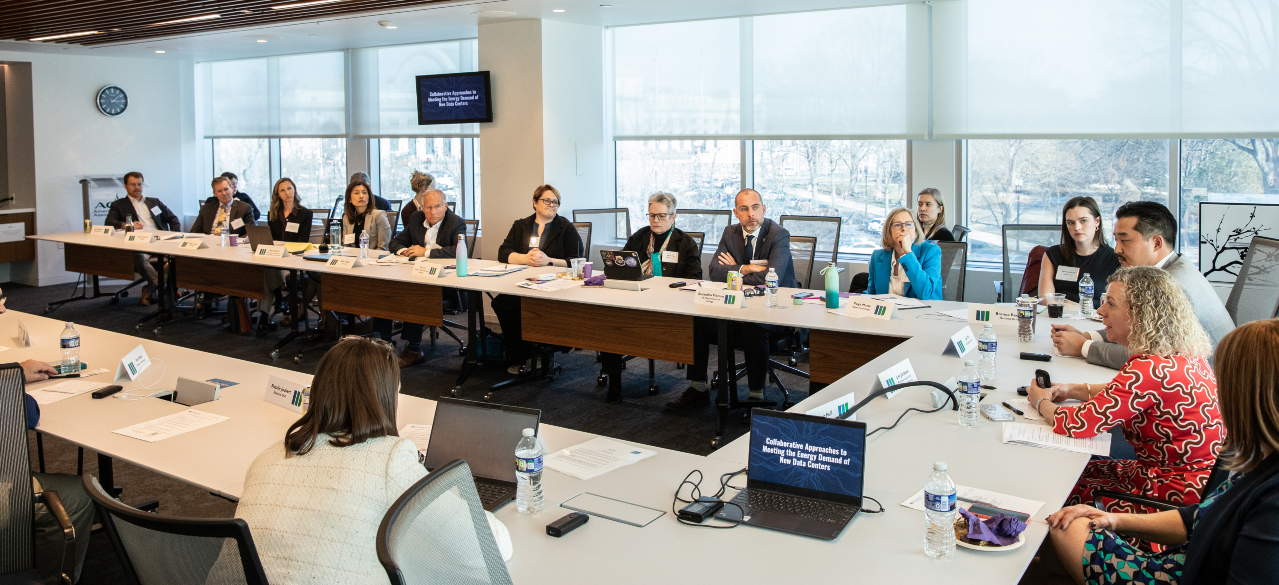By Emmy Deignan, Policy Associate, BCSE
The AI race has begun – a race not only to innovate, but to secure investment, train the next generation of skilled workers, collect data, and optimize the energy grid. Driven by growth in AI and data centers, U.S. energy demand is expected to surge by 35-50% between 2024 and 2040. In support of this race, energy providers are scaling up production, seeking to meet this moment of unprecedented energy demand.
This month, BCSE and members Aspen Technology and Enchanted Rock convened a roundtable discussion in Washington, DC to explore how the United States can harness AI to identify and implement energy savings.

Above: Leaders from industry, academia, and government discuss what is needed next to boost energy supply and strengthen the grid in the age of Artificial Intelligence at BCSE, Aspen Technology, and Enchanted Rock’s roundtable in Washington, DC.
Here are the top takeaways from the discussion:
1) AI is a boon for business.
AI has been helping companies make more sustainable decisions for decades. Even before the recent advancements in AI technology, AI has been used in process industries for hybrid modeling of complex operating systems, power generation and transmission planning, supply chain management, and more – helping companies to avoid costly mistakes and increase productivity. AI capability also helps companies accelerate innovation by enabling faster review of alternatives and quicker implementation of the optimal solution.
Increasing the utilization of these technologies will require lowering costs and educating companies about their most effective use, but the possibilities for improving business decisions are extensive.
2) Meeting growing demand requires utilizing the entire energy toolkit.
All energy solutions and generation sources have a role to play in meeting this unprecedented load growth.
Expediting the timeline to develop and interconnect renewable energy and natural gas projects to the grid will be critical. According to the 2025 Sustainable Energy in America Factbook, 317 GW of new capacity applied to interconnect in the seven U.S. independent system operators in 2024 alone – representing nearly a third of the current installed U.S. power system. Reforms to the federal permitting and siting processes are needed to quickly deploy the energy resources that are needed to meet growing demand.
At the same time, demand-side solutions also have a role to play in boosting the efficiency of consumer energy use, limiting peak demand and lowering the risk of blackouts. Private and public sector investment is key to reducing up-front costs and increasing consumer uptake of energy efficiency solutions. Flexible data center designs that include co-location of energy generation, as well as industrial AI solutions that enable more efficient training and operation of AI, will also play a role in reducing the strain on the energy grid.
3) Public-private partnerships are key to increasing energy supply.
In order to connect projects to the grid at a pace that matches the rate of economic growth in the United States, business leaders must work hand-in-hand with policymakers on crucial regulatory and policy innovations.
For example, public utility commissions are key decision makers in this policy landscape, and energy stakeholders must be prepared to work with the public sector to establish a better market design. Energy advocates must bring their best ideas to the table for meeting data center energy demand and emphasize the urgency for efficient policy adoption.
4) Supply chain constraints require a balancing act.
Consumers expect stable and resilient energy supply, but the grid requires major upgrades and is sensitive to load fluctuations and bi-directional power flow. As the United States expands its grid, energy production, and data center development, energy supply chains will be pushed to the limit.
Supplying resources to build data centers may mean that other projects will face delays – and vice versa. Cooperation on building new projects and scaling up existing infrastructure to properly navigate a constrained supply chain is essential.
About the Author: Emmy Deignan is a Policy Associate for the Business Council for Sustainable Energy.

